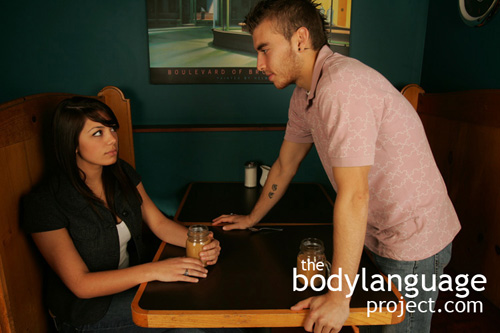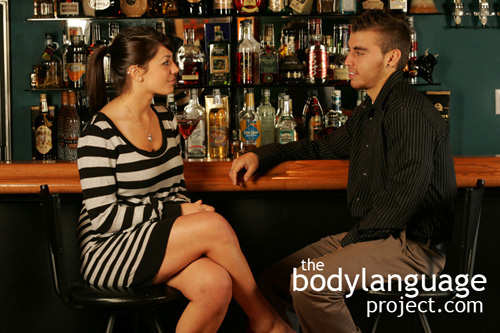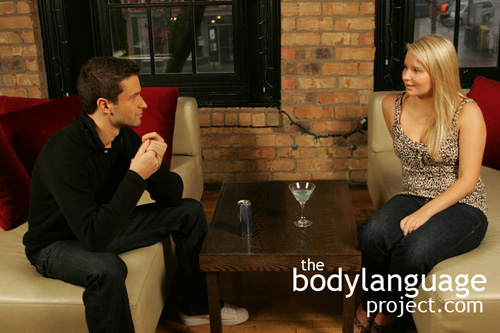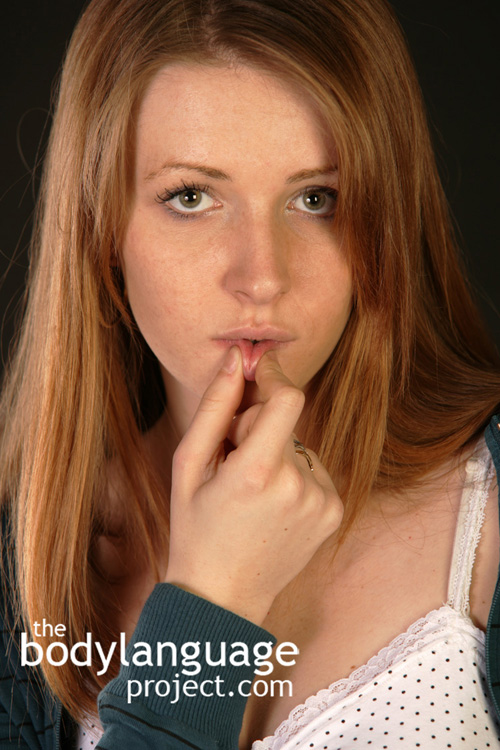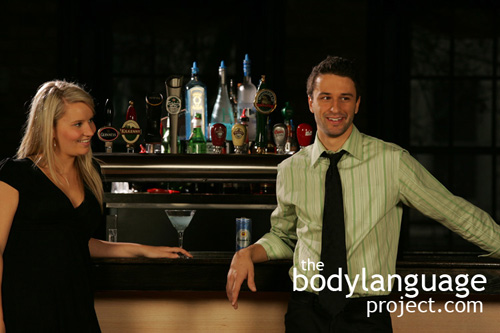Touch reduction is usually accompanied with stressful questions or when information is presented that creates anxiety. Closeness can also be useful when assessing someone because it will invoke distancing desires. When talking with a spouse or child, sit as close as that which you are accustomed to before taking up serious matters. If someone is hiding something, they will usually push away or even stand up looking for ways to exit or change the subject. Holding the hand of a child can be particularly useful when discussing matters of dishonesty. If they wish to exit the discussion, they will try to tug their hand away.
Tag Archive for Flight Response
Blocking Behaviour
by Chris Site Author • March 6, 2013 • 0 Comments
Blocking is a term used to describe when a person wishes to distance themselves from a distressing stimulus. Blocking is a part of the fight or flight response, and takes the form of the flight element because it creates distance between things we wish to avoid.
“Eye blocking” happens by covering the eyes either wholly or in part. When viewing disturbing images on the movie screen or even in real life, people will bring both hands up to cover their eyes or will bring them to the sides of their eyes like the blinders used on horses to keep them from being distracted. However, in this case the blinders are a nonverbal signal meant to cut something off from view instead of driving focus on them. What is being said is “Oh my dear, I can’t believe what I’m seeing.” Eye blocking is not just limited to things seen, it can be the results of hearing undesirable things as well. Blocking can be abbreviated as when one or both hands come up to rub the eyes, or seem to pinch the eyes from corner to center with just one hand. Other times, the hand comes up and covers the eyes in part, with a partly clustered set of fingers so that view isn’t entirely obstructed. This might appear as though the person is thinking, but no thought is going, just a desire to look away. Blocking can be done by briefly touching one eye with the index and middle finger in response to hearing something negative, by closing the eyelids for a longer than normal duration or more dramatically by closing them tightly in response to hearing some particularly distasteful. Blocking can also be done with books, articles of clothing or any other object.
Blocking can happen through the creation distance and also with arms and legs. For example, it is common for people to move away from things, and people they don’t like, and move closer to things and people they do like. We might see distance forming when a particularly bad offer is tabled at a boardroom between competing firms. The contract might be shoved away, or parties might lean away from the table or away from the speaker or the feet might be moved toward the nearest exit. We call this type of body language “distancing language.” The legs might be crossed away from detestable people, so the outer part of the leg cuts off access to the ventral (the vulnerable) part of the body. In an extreme version, the arms can grab the ankle when crossed away so as to lock it in place. This is an unmistakable signal of rejection through it’s denial of access. The hands also display like and dislike. When a couple is in disagreement they will be seen moving their hands away from their spouse, usually off the table and onto their laps and when they agree their hands will be brought back up or moved closer. These sorts of general agreement indicators happen free-flow in real time so they reflect the true sentiment and the stimulus that has caused it.
Nervous Hands
by Chris Site Author • March 6, 2013 • 1 Comment
A telltale clue to nervousness is when the hands begin to shake. Since the hands are designed for fine motor control, they are easily affected by a surge of adrenaline stimulated from stress from nervousness or excitement. Any stimulus, good or bad, can stimulating the muscles in the hands to fire out of control creating quivering. The limbic mind driven by fight or flight response is what causes hand shaking which makes the nonverbal cue particularly honest and predictive.
As mentioned even positive events can create shaking, such as an excellent hand in poker or seeing someone we have a deep crush on. Hands more often than not however, will quiver when bad things happen that send us into a fear response such as preparing to take the stage to present in front of an audience, being in a serious car crash or swerving to avoid one at the last minute. When in any sort of confrontation, we can also experience hand shaking. To decide what sort of stimulus, be it fear or excitement that it causing the quivering one doesn’t have to go much further than context. From there, it should be obvious why someone is shaking.
To disguise handshaking, some people will grasp at objects such as drinking glasses, will clasp their hands together or occupy them with “busy work.” Other times people will steady their uneasy hands by grabbing the hand of a relative, cupped them hand-in-hand at the chest, or thrust them underneath the armpits or in pockets. People who suffer from pronounced handshaking will develop elaborate ritualized gestures to keep their hands from being noticed. They will play with the arms of eye glasses, twirl pencils, or fidget with clothing. To others it will go unnoticed because they will appear as a normal part of their repertoire – their baseline.
Teenage girls meeting a celebrity pop singer are often seen fidgeting with their hands as they defy gravity by bouncing up and down. Their hands will often be flung sky-high and they clasp together in excitement. This is nervous energy personified and the hands show the limbic system in overdrive. Watch for this “tell” in a poker game as hands might come together underneath the table to steady each other. Hand shaking in poker, however, can be due to either fear of getting caught bluffing or the excitement good hand. In this case, it is a person’s baseline that helps predict which of the two is really happening. Hand quivering is important only when it deviates from a person’s normal repertoire of actions. For example, if hand quivering suddenly starts up or stops when discussing a particular event, we know that event is the root. It will then be our job to decide why the event caused nervousness or excitement. The same goes for any other cue, be it a new person added to a social gathering, nearing the edge of a cliff (fear of heights), being asked a question that is difficult to answer and so forth.
Freeze, Flight or Fight
by Chris Site Author • March 6, 2013 • 0 Comments

Even the fear facial expression is a classic “freeze” response. It’s as if the face has been caught in a flash of emotion.
The fight or flight response is a bit a misnomer. It’s not actually how humans or other animals respond to stress and danger. Lazy by nature and especially cautious of injury, recall we didn’t have doctors and hospitals thousands of years ago and even today most animals receive no secondary care from veterinarians, we have evolved the proclivity to handle situations in more appropriate ways. Most animals, humans included, will naturally sequence freeze, flight and flight in that order. Freezing is important to assess the situation, for how does one know what they are running from, and in what direction, if they don’t first identify the object of their fear.
White-tailed deer will first begin by winding predators, and if they sense that it is close, may seemingly flee instantly, but usually they will freeze in place to first identify the type of predator, human or other, its location, and its proximity. They do this by tilting their heads back and passing deep breaths into their lungs through their noses and over a specialized fluid filled structure called the vomeronasal organ. For deer, it is their sense of smell that is their primary means of safety. Since their eyes are much less acute than their noses, they rely on catching movement from predators especially when they are being stalks from downwind when scenting isn’t an option. When movement is caught, deer will try to “flush” the danger by stomping a foot rhythmically before fleeing. The foot stomp is a deer’s way of nonverbally signaling to a predator that they have been made, that the “jig is up”, so to speak, and that it’s time to identify themselves. The deer knows that a predator is in the vicinity though sight, smell and sound, or possibly just has a hunch that something is amiss, and instead of fleeing outright wants to be totally certain before “hightailing it!” To a deer, or human, running at all potential danger is wasteful and time consuming and not always appropriate. By the way, the deer put his white tail up (the underside of a deer’s tail is white, hence the original of its name), and will snort-wheeze which is done by forcefully exhaling pressurized air through their mouth, to signal to predators that pursuit is futile. Because animals have no verbal language, they communicate using nonverbal signals, and in this case, it happens even across species.
When humans are presented with fearful situations, they also tend to freeze. Like in animals, movement attracts attention and so to become a less obvious target to attack, the body becomes motionless. Survivors of the Columbine shooting in 1999 played dead so as to be overlooked by the shooters Eric Harris and Dylan Klebold despite being in plain view. Some of the survivors were just a few steps away from the shooters. Freezing is an evolutionary strategy that reduces the chances that predator will identify them and switches off their attack response. In everyday life we see the freeze response when people are caught in the act of theft, when caught lying, or when hiding something. Is it an accident that police officers yell “Stop right, there” or “Freeze scumbag” when they’ve got a suspect in their sights? Screaming this might even yield a momentary freeze response if done loud enough. That is until the suspects get a chance to see who is it that uttered the command, and in which direction they should run. Shoplifters have been identified by overhead surveillance, among other body language, by the way they seem to reduce their profile, hunch over and reduce their arm movements. This is the art of “hiding in plain view” and is no different from what anyone else does when they want to get by unnoticed. I know my son is up to no good when things go particularly quiet in the house. More often then not I’m right!
People will habitually freeze when they are scolded, children and adults alike, and sometimes reduce their breath rate especially under intense scrutiny. Stress can therefore cause shallow breathing, which is why we remind people through meditation to take deep breaths to dissipate tension. You may notice someone holding their breath or even pushing breath through their mouths, we call these sighs, and it indicates stress and hidden tension. Sometimes the cheeks are puffed out where air is slowly exhaled and other times sign are riddled throughout conversation or while busy doing other tasks. If you notice someone consistently doing this you know it’s their way of “Blowing off steam.” Be watchful of the freeze response because in context can tell you that someone is stressed and is trying to go under the radar. Be particularly conscious of freezing that happens suddenly by the presence of others as it will tell you who is the object of fear. Children that suddenly freeze when a relative comes near, is telling you that they feel uncomfortable around them, and this should worry you. A wife that clams up when her husband is around, but is otherwise bubbly and personable, might be saying that she fears his reprimand because she has upset him, or might even fear upsetting him by making a social blunder. When it comes to fear-freezing, it is the sudden change from fluid to freeze that tells us what has caused it.
Signs Of Aggression
by Chris Site Author • March 6, 2013 • 0 Comments
We’ve seen the hands-on-hips posture before but it resurfaces again in the aggression classification because it is ready posture. In this case, the hands on hips, feet together at attention is accompanied by leaning forward with the head and chin up, or out, and exposed. The hands-on-hips puffs the person out making them seem larger and the feet spread at shoulder width increases stability putting them in a fighting stance. Observations have shown us that ignoring the puffed out chest is to be done at one’s own peril as it is a very strong indicator that a person is about to strike out in aggression. The classic ‘in-your-face’ type of posture indicates readiness for fight and isn’t to be confused with a business ready posture. The accompanying clues which are discussed next, shows an intent to fight, but also tension so there is overlap in fighting nonverbal language and that which stems from other negative emotions such as displeasure, fear, anger, antipathy and disgust. Therefore it is the context, once again, that will tell us the root source of the body language, be it fight or flight.
As aggression nears, our blood “boils” and rushes to the surface of the body making our faces and ears turn red with anger. While blood doesn’t actually boil there is some truth to it. As our nervous system is shifted in the “fight or flight” response our blood pressure increases through a faster heart rate preparing us for action. Since our faces have a high concentration of capillaries and vessels, and the vessels, especially in the cheeks are much wider in diameter than other areas of the body, coupled with the thin skin in the face, permit the redness of the blood to show through in the characteristic “flushing.” This anger reaction shouldn’t be confused with feeling embarrassed or the blushing we see through exercise. The accompanying cues in cluster will tell us which emotional response we are seeing.

Fists clenching is an early sign of aggression. It shows that the body is ready to fight – even if not literally by punching someone.
During aggression we might see the arms show defensive postures by becoming crossed showing a negative emotion, or dropped to the side and clenching. Fists clenching is an important cue to aggression since it indicates the underlying thought process that one is nearing physical action. Other cues in the cluster include finger pointing, overall tensing of the body or extreme body loosening to ready for fighting, tightening of the jaw and lips (called “lip occlusion”), quivering in the lips, frowning, furrowing, or lowering the eyebrows, dilated pupils, squinting of the eyes, crotch displays such as legs open, sneering or flared nostrils.
The technical term for flared nostrils as mentioned before is “nasal wing dilation” and is of particular in the fight and flight response because it tells us that someone is actively oxygenating their bodies in preparation to do something important. Our bodies consume oxygen during work, and we can get our bodies ready by loading up hemoglobin which is the carrier of the oxygen molecule, just in case it’s needed for a condense bout of work. As people get ready to fight their chests can be seen rapidly expanding and contracting as if panting. The body is essentially saying “We’ve probably got a problem on our hands, time to load up on oxygen as we might need to fight or take flight!” Sometimes though, nasal wing dilation is in response to doing anything physical at all, be it to move a heavy sofa or taking to a flight of stairs. Other times, nostrils flare when aroused by a potential mate who is seeking to take up an alluring scent laced with sexual pheromones. However, as mentioned this cue can be very important in certain context as it may provide clues to potentially aggression. School aged children should learn this nonverbal cue early on so as to diffuse aggression by bullies.

Nose flaring or “nasal wing dilation” signals displeasure and negative thoughts. Noses flare because extra oxygen is being consumed to prepare for battle.
It might be counter-intuitive to think that opening the body up and keeping it loose, is a sign of aggression, since it exposing the body to attack, but in this cue cluster, the posture challenges others to attack. The limbs can seem to dangle from the body and the upper torso might begin to sway back and forth, or bob, similar to what a boxer does seeking an angle to attack. Only in this case, it happens much more discretely such that a surprise attack might be possible.
Conversely, the arms and body can become stiff and rigid as they prepare to defend whereas others will visibly start shaking. As a last resort, aggressive individuals may begin expressing the same thoughts over and over again to assert their position in effort to have their opponent back down. Under more extreme cases, people fall back into more primitive displays of aggression such as banging fists against a table, slamming doors, and even throwing objects. Figuratively, the message being advertised is that the table, the door being slammed, or the chair being thrown, will soon be you!
As the person nears aggression they will begin to invade your personal space, sometimes even ‘head-to-head’ and issue verbal challenges and might burst into nervous laughter even though nothing funny has been said. The solution to aggression is to always back away and give the person as much space as possible while showing defensive postures. Nearly all individuals will cease aggressive behaviour given the proper cues and switches, while other times, the only avoidance to physical combat is the flight response. In other words, run!
Double Arm Hug
by Chris Site Author • March 6, 2013 • 0 Comments
Hugging one’s self is a defensive and closed body position. Those who take up this posture invariably exclaim that they are cold, which is sometimes the case, but usually the cold sensation is a function of feeling awkward and uptight. When temperature is actually a factor, the arms will cross and the hands will be tucked under the armpits in effort to heat them up. Other times, the arms will hug the body tightly in a full embrace but they will shiver and hold their legs stiff crossing them tightly as if they need to use the washroom. If these cues are not present, and we still see a double arm hug it’s due to feeling uncomfortable and not feeling cold. By watching for all the cues in the cluster it is easy to tell which attitude is really present.
Those that habitually cross their arms are usually not aware that they are sending a bad message to others. However, arm crossing is a universally defensive posture so it is important to be aware of its use. In a business meeting or in a job interview holding the double arm hug posture will be read by others as being disagreeable even if the person really is cold. This effect might pass over if other’s feel the same chill, but when only one person in the room is seen looking uncomfortable, they will sense that something is up, even if just subconsciously. Those that are timid and shy by nature can also get the short end of the stick as others will quickly dismiss them as rude or antisocial.
When someone complains of feeling cold where the room temperature doesn’t warrant it, is a direct response to a limbic brain command that shunts blood from the skin toward the major muscles in preparation for the fight or flight response. The large muscles like the legs and arm need blood in order to prepare for combat and escape. This is largely in effect when people seem to go pale when under extreme stress and why others lose their apatite when under pressure. Again the blood moves away from the intestines toward the major muscles producing a cold sensation on the surface of the skin as blood moves deeper.
Being Opened And Closed Through The Legs And Arms
by Chris Site Author • March 5, 2013 • 3 Comments
Throughout this chapter being “open”, refers to a frame of mind that is willing to accept information, to hear others out and to consider taking action whereas a closed mind, or being closed indicates the opposite. As mentioned previously, having an open and receptive mind is indicated in body language through the absence of closed postures.
It has been shown that frowning requires more muscles and effort than does smiling and so naturally our default facial expression is the smile. Similarly, openness as it relates to body language is the default mode because a relaxed body requires less effort than one that is tensed or closed. To take a negative posture, we must actively close our bodies off requiring effort and to exercise effort we need motivation. In this case, motivation can come from any fearful or unwanted stimulus that precedes a fight or flight response. That is to say that, closed body language are the postures we while see as a negative decision is being analyzed and so is a predictor of a bad outcome.
Being completely open allows us take our most comfortable position, such as what we might do on a couch or in bed in our own house. We might lay our arms out and take up space, put our hands above our heads, spread our legs open or even lay down completely. Having open body postures is akin to being totally exposed to the word and all the harmful things in it, but possessing no fear of harm. Of course, we permit ourselves to hold open postures precisely because we expect nothing harmful to happen. In other words, our bodies are permitted to relax when we are open and contract and tighten when we are closed.
Thus, it takes muscular effort to close the body off whereas open postures occur without action at all. When viewing open body language imagine the extremity of the postures, which as mentioned, can be likened to being on a couch at home. An even more dramatic example is to view open body language as that language exhibited by someone who is intoxicated. Their language is loose, their arms sway freely, they stagger, they have no worries about being ridiculed or attacked and they don’t cross their arms or legs. The cerebral cortex of the drunk, the part of the brain that helps in judgment, amongst other brain centers, is disrupted producing depressed inhibition, increases talkativeness and makes people feel more confident. Alcohol also increases pain thresholds, numbs pain, and makes people feel sluggish because it suppresses the brains ability to function. So for our purpose, the drunk makes a nice example of open body language since he lacks fear, but even if he did, he’d still lack the coordination and strength to carry out a defensive posture.
As a rule of thumb, closed body language happens whenever one of our limbs crosses the mid-point of our bodies. Such is the case during leg and arm crossing. Open postures, on the other hand, happen when the legs and arms remain un-crossed leaving the torso and groin exposed. Of course there are various ways in which the legs and arms can be crossed and these all mean different things which we cover next.
Sudden Changes In The Hands
by Chris Site Author • March 5, 2013 • 0 Comments
Hands can show real-time changes in an attitude. Imagine a couple sitting enjoying a romantic meal at a restaurant, with their hands bridging the gap between them as they sit facing one another hand-in-hand. The topic of conversation flows freely, but suddenly switches to a contentious issue, what would you imagine would happen to their hands? When there is disagreement between people, the hands are pulling inward and away from those we disagree with. This sort of behaviour can happen suddenly especially on a heated topic, but can also happen over time on issues that gradually show differences. When total disagreement is present, the body will even be withdrawn where the hands will rest on the lap. Taking the example of the couple above once again, imagine that only one of the two experiences a change in thought to the topic, their hands might remain outstretched in the center of the table and turn palm up as if to offer the idea to their partner as if to try to change their mind. Gradually the other might re-advance to join their hands once again or move them to their lap. As the argument fails, both parties hands might graduate away. If disagreement continues, feet might orient toward the door followed by torsos than finally their heads.
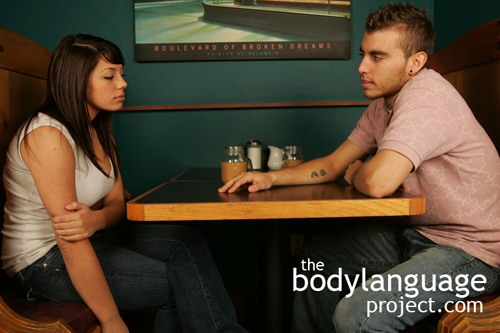
Arms are withdrawn when disagreement is high. These arms are busy protecting the torso in a single arm closed body posture – an ‘incomplete hug.’
Arms withdraw for a number of reasons but our subconscious mind tunes into our flight response and pulls hands in when we fear they will be hurt, and especially when they are hurt. When we touch a hot stove or hear a loud bang, our arms draw quickly into our bodies to protect them. This happens instantly with no ability to stop it. Likewise, our hands come in when we are worried or threatened despite a lack of physical threat. When our arms come in, our minds feel that they can block attacks better even when they are emotional in nature. Hands can be withdrawn for any number of reasons, not just disagreement, such as dishonesty. Honest hands are palm up, offering something to another person, or palm down in a confident authoritative position, but when hands are pulled away, they signal hidden thoughts of disagreement and lack of connectivity.
Hands can also suddenly change in terms of use of illustrators and seem to pause, stop or slow in their rate of use. Sudden cessation of gesticulation can indicate a freeze response due to being caught in a lie especially when the context warrants it. This is part of the flight or flight response as liars are trying to seem less noticeable. They are “hiding in plain sight” and to do this it is necessary to move less as movement attracts attention. Reducing expressiveness means fewer “tells” or so the lying mind thinks. When hands that are usually busy while talking according to a baseline, suddenly begin to slow, or become less expressive, it can signal a lack of enthusiasm or confidence for the topic. Whatever happens to the hands, when they suddenly change, we know that something internal has changed and it is usually tied directly to whatever is happening in the moment.


